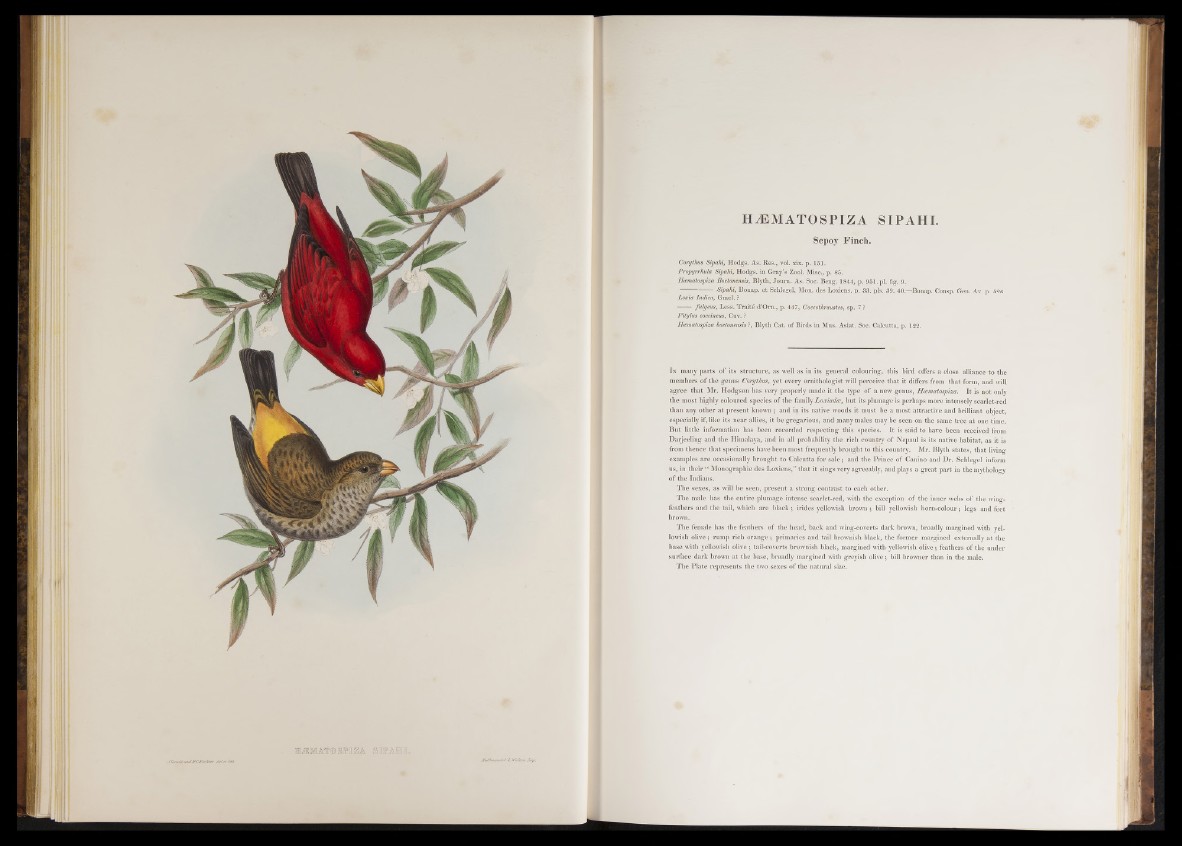
HÆMATOSPIZA SIPAHI .
Sepoy Finch.
Corythus Sipahi, Hodgs. As. Res., vol. xix. p. 151.
Propyrrhula Sipahi, Hodgs. in Gray's Zool. Misc., p. 85.
Hæmatospiza Boetonensis, Blyth, Jo um . As. Soc. Beng. 1844, p. 951. pl. fig. 9.
----------------Sipahi, Bonap. e t Schlegel, Mon. des Loxiens, p. 33. pis. 39, 40.—Bonap. Consp. Gen. Av. p. 526.
Loxia Indica, Gmel. ?
fulgens, Less. T ra ité d’Orn., p. 447, Coccothraustes, sp. 7 ?
Pitylus coccineus, Cuv. ?
Hæmatospiza boetonensis ?, Blyth Cat. of Birds in Mus. Asiat. Soc. Calcutta, p. 122.
In many parts of its structure, as well as in its general colouring, this bird offers a close alliance to the
members of the genus Corythus, yet every ornithologist will perceive that it differs from that form, and will
agree that Mr. Hodgson has very properly made it the type of a new genus, Htematospiza. It is not only
the most highly coloured species o f the family Locciadas, but its plumage is perhaps more intensely scarlet-red
than any other at present known; and in its native woods it must be a most attractive and brilliant object,
especially if, like its near allies, it be gregarious, and many males may be seen on the same tree at one time.
But little information has been recorded respecting this species. I t is said to have been received from
Darjeeling and the Himalaya, and in all probability the rich country of Nepaul is its native habitat, as it is
from thence that specimens have been most frequently brought to this country. Mr. Blyth states, that living
examples are occasionally brought to Calcutta for sa le ; and the Prince of Canino and Dr. Schlegel inform
us, in their “ Monographic des Loxiens,” that it sings very agreeably, and plays a great part in the mythology
o f the Indians..
The sexes, as will be seen, present a strong contrast to each other.
The male has the entire plumage intense scarlet-red, with the exception of the inner webs of the wing-
feathers and the tail, which are black ; ¡rides yellowish brown ; bill yellowish horn-colour; legs and feet
brown.
The female has the feathers of the head, back and wing-coverts dark brown, broadly margined with yellowish
olive; rump rich orange; primaries and tail brownish black, the former margined externally at the
base with yellowish olive ; tail-coverts brownish black, margined with yellowish olive; feathers of the under
surface dark brown at the base, broadly margined with greyish olive; bill browner than in the mi de.
The Plate represents the two sexes of the natural size.